Indianapolis Motorcycle Accident Attorney
Why Choose Crossen Law Firm for your Motorcycle Accident Case
When a motorcycle accident occurs, your world can feel like it’s been completely upended. As an injured motorcyclist, understanding your legal rights surrounding the accident, and how to be fairly compensated for the damages, is an essential aspect of getting back on your feet. The process of negotiating with insurance and settling claims can be complex and confusing.
Luckily, having the right legal representation can often go a long way in making the process go smoothly and efficiently. An Indianapolis motorcycle accident lawyer will help you navigate negotiating with insurance, communicating with another automobile driver or truck driver, and with any court processes, to ensure that you receive maximum compensation.
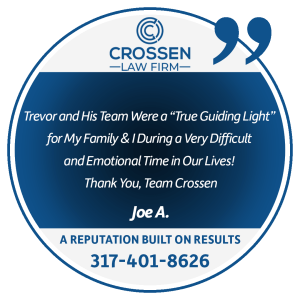
If your accident involves an injury, the severity of your injury may also stop you from being able to negotiate on your behalf. A motorcycle accident lawyer will give you peace of mind that your affairs are being handled by an expert.
Injured motorcycle riders and motorcycle accident victims should never have to fight to get compensation. Crossen Law Firm offers experienced motorcycle accident lawyers in Indianapolis who have the expertise and dedication to make certain that your personal injuries claim is handled fairly by insurance companies.
We will help you handle every detail of the process from applying for your serious accident claim to making sure that you receive a fair value settlement. With a multi-million dollar track record of recovered compensation, our team is known for helping injured bikers when they need it most.
Our Motorcycle Accident Attorneys Focus on What Matters

As soon as you contact us, we will go to work to find out all aspects of your case that matter for your claim. If there were multiple motorcyclists involved, we will make sure that each negligent party provides due compensation for their responsibility in your accident.
Insurance companies will often try to avoid making full motorcycle accident claim payouts. At Crossen Law Firm, though, we have years of experience negotiating with difficult insurance companies. Our goal is to always get you the full amount for your insurance claim/
If you or a loved one have been in a motorcycle crash or collision, reach out to a member of the Crossen Law Firm today. No one should have to wait to get their life back on track.
You can schedule your FREE consultation by phone at 317-401-8626 or by contacting us online. Our contingency-free pricing means you pay nothing unless we win your Indianapolis motorcycle accident case.
Indiana Motorcycle Accident Statistics
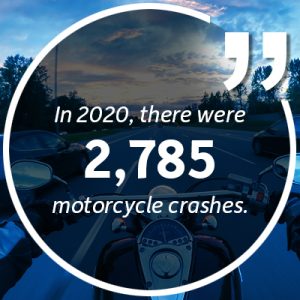
The following data is from a 2020 report by the Indiana University Public Policy Institute:
- In 2020, there were 2,785 motorcycle crashes
- Those wearing helmets were less likely to sustain fatal injuries
- Brown, Switzerland, and Pike counties have the highest rates of motorcycle collisions
- Accidents occurred most often between 3 PM and 6 PM
- The highest number of collisions occurred in June and August
- The severity of injuries or likelihood of fatalities also depended on weather and road conditions
Indiana Motorcycle Accidents FAQs
Below we’ve rounded up some of the most common questions people have about motorcycle accident cases in Indiana. If you have additional questions or wish to discuss your accident with us, please reach out to our team of experienced motorcycle accident lawyers.
What Are the Most Common Causes for Motorcycle Accidents?
A motorcycle accident can be devastating, so it’s important to understand what the common causes are and how to avoid them. Accidents are never 100% avoidable, so always drive your motorcycle with caution and wear a helmet. If an accident happens, we’re on your side to help you through the process of receiving a fair settlement.
According to the Federal Highway Administration, here are some of the most common causes of motorcycle accidents:
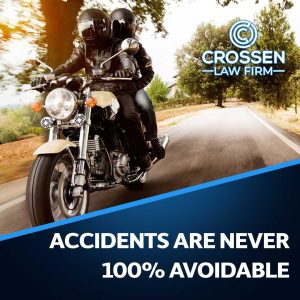
- Road Conditions: These can include construction, curvy or winding roads, decreased visibility for driveways or at intersections, potholes, and other adverse road factors.
- Weather: Driving any vehicle during rain or snow storms can increase the likelihood of a crash. When roads are wet or icy, pay extra attention to your speed and the speed of those around you. If conditions are unsafe, such as during heavy rainfall or a blizzard, avoid driving any motor vehicles if possible.
- Driver Error: Whether due to age or inexperience, driver error can account for a motorcycle wreck. Always understand the vehicle you are driving, and when possible, practice safe driving in various road and weather conditions to become more comfortable. Additionally, always know local motorcycle laws.
- Speed and Reckless Driving: One of the biggest factors in accidents, and whether they cause an injury, is the speed at which vehicles are driving. Always follow posted speed limits, and take road and weather conditions into account.
- Inebriation: The influence of drugs and alcohol impairs a driver’s ability in many ways. Drunk driving is a leading cause of fatal accidents. Being inebriated may affect everything from a driver’s reaction time to their vision. Never operate a vehicle while under the influence of drugs or alcohol. If you take any medications, always discuss with your doctor about whether it is safe to operate a motor vehicle while taking the medication.
- Distracted Driving: Talking on the phone, listening to music, eating, drinking, or looking at your phone or another device, can all cause you to be distracted for a moment while driving. Unfortunately, a moment’s distraction is often enough time for an accident to occur.
- Traffic Conditions: Traffic conditions such as congested traffic or traffic jams, parked vehicles or other obstructions, and the average speed of other vehicles can all contribute to accidents. Always be aware of your surroundings when riding your motorcycle.
- Drowsy Driving: When drivers have not had enough sleep, or are otherwise tired, their ability to react quickly or to stay awake on the road is at risk. Stay alert to the behavior of vehicles around you, such as seeing a car that weaves on the road or when another vehicle seems to be stopping and speeding up at unpredictable intervals. Never ride your motorcycle when you are feeling drowsy.
Additionally, pay attention to the maintenance of your vehicle. Popped tires, or faulty parts, can cause major issues including crashes. If a maintenance issue leads to an accident, the manufacturer of the part or the person who installed it may have been negligent.
What Are the Most Common Injuries in a Motorcycle Accident?
Motorcycle accidents often result in injuries and medical expenses. Injuries to the lower parts of the body, such as the legs, are one of the most common types of injury in a motorcycle accident. These can occur from things such as road rash when sliding or dragging along roads, or the motorcycle falling on top of the rider’s legs.
This type of injury may also result in broken bones, such as in your legs or arms. However, despite these being the most common types of injury, they are often not the most serious injuries. Severe injuries to a motorcycle rider’s chest, abdomen, and head are the most traumatic injury and are the most likely places to lead to a fatal injury.
Traumatic brain injuries and spinal cord injuries can lead to a lifetime of medical challenges for injured motorcyclists. To better protect yourself, and your passengers, against serious injury and head injuries, always wear the proper gear such as your helmet when riding a motorcycle. Helmets reduce the likelihood of fatal accidents considerably.
Should I See a Doctor After a Motorcycle Accident?
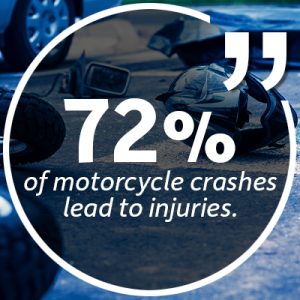
While not all motorcycle crashes lead to injuries, most motorcycle accidents (almost 72%) do. So, it is likely that you will need to see a doctor after suffering a motorcycle crash or any vehicle accident.
In addition to obvious injuries, such as road rash, it is always important to see a doctor after an accident because not all injuries are immediately visible or feel immediately painful or severe. If your head is hit at all, you could have a concussion without knowing it.
If you are bruised, you may have internal bleeding. Neck injuries are common because of the abrupt motion of accidents. While the worst-case scenario will hopefully never happen, it is better to seek medical attention and be thoroughly examined by a medical professional after any accident no matter how minor the accident, or an injury, may seem.
Additionally, any medical records that result from an accident may help serve as evidence for your personal injury lawsuit. A doctor can assess how you are doing both physically and emotionally following an accident, which will help to build a case for your claim.
When being examined by a doctor, be sure to note any pain you feel and to address any injuries you physically notice as well. Even small injuries, such as minor cuts and scrapes, should be noted.
If your insurance company does not completely cover any medical care that you receive, the at-fault party may be liable to cover any additional or uncovered expenses.
Is There a Statute of Limitations for Filing a Personal Injury Claim in Indiana?
With any claim, there is often something called a “statute of limitations.” This statute puts a specific time frame on when a claim or case must be filed after an incident.
In the state of Indiana, the statute of limitations for personal injury claims is two years. However, in some cases, there may be exceptions to this, so it is always best to discuss your claim with a lawyer.
This statute of limitations is slightly different in the case of wrongful death. If you are the relative of someone who was killed in, or as a result of, a motorcycle accident in Indiana, then you also have two years to claim wrongful death under the statute of limitations.
However, there is a slight difference to this. If a death was the result of an accident, the statute of limitations is two years after the death rather than after the accident. This is because someone may die as a result of their injury, but not immediately during the event of the accident.
In general, the more quickly you speak with a motorcycle accident attorney and make a claim following an accident, the stronger your case. If the statute of limitations has passed, your case will likely be dismissed and you will no longer be able to pursue fair compensation for your injury or loss.
What Kind of Compensation Am I Eligible for after a Motorcycle Accident in Indiana?
The amount of compensation motorcycle accident clients are eligible for will vary on a case-by-case basis. However, there are essentially two main types of compensation for which you may be eligible.
These are:
Economic Damages: Economic damages are for items or things that have a clear price value attached to them. This includes things such as the cost of your motorcycle itself if it has been totaled, or the cost of repairs for it if that is a possibility. Economic damages also include things like medical bills and expenses, whether you need physical therapy, out-of-pocket costs associated with your care, lost wages if you need to take time out of work, etc.
Non-Economic Damages: This type of damage refers to elements that don’t have a direct cost associated with them, but you should still be compensated for. This includes things like pain and suffering, emotional or mental stress or anguish as a result of the accident, reduced quality of life, permanent impairment from your injuries or as the result of mental suffering such as post-traumatic stress, and more.
For the best chance of receiving fair compensation for your accident, discussing your case with a accident attorney is your best route. They will be able to help you navigate the complex process of filing a claim, gathering evidence to support your claim, and ensuring that you are compensated for both economic and non-economic damages that you have suffered.
How Is Fault Determined in Indianapolis Motorcycle Accidents?
Accidents happen fast, and may not have eyewitnesses who were not directly involved in the accident, which means that finding out who is the at-fault driver can often be difficult.
Indianapolis motorcycle accident lawyers’ work revolves around understanding the evidence and helping you prove your case.
Some of the aspects that are used to determine who was at fault include:
Evidence: Photographs of the accident scene are often big factors in proving who was at fault in fatal motorcycle collisions. It is always important to call the police after an accident, as they will collect any necessary evidence. In addition, if you are able, you should try to take photographs of the scene of the accident, as well.
Witnesses: Witness statements are a big factor in proving who was at fault. Statements will be collected from the drivers, passengers, and any bystanders to the event.
Damage Inspection: Where and how a vehicle is damaged in a motorcycle accident, as well as what injuries are sustained by the motorcycle rider, can often be a key aspect of understanding the crash. This may include elements such as vehicle black box data, inspection of dents and other damage, and crush profiles.
Police Reports: The reports that any police officers make at the scene of the accident are important pieces of evidence. They will catalog the most immediate information about the crash.
How Should I Work With Insurance Adjusters After an Accident?
Following an accident, you should receive a call (or make a call depending on the severity of the accident) from an insurance adjuster. Insurance adjusters’ jobs are to assess the damage sustained in the accident and make you a compensation offer based on their assessment.
Their assessment may in part be based on what kind of insurance coverage and/or collision coverage you and the other drivers in the accident possess and whether or not that includes underinsured motorist coverage.
However, the insurance company will likely want to pay out the least amount that they can. This means that their compensation offers are not often the full amount that you deserve. They often will not factor in elements such as pain and suffering, emotional strain, or loss of wages. Because of this, it is essential to have legal counsel from someone who can help negotiate with them on your behalf.
The insurance company may try to bully you into accepting their offer, but you are under no legal obligation to accept the first offer that they give to you. It is always best to consult with an Indianapolis motorcycle accident lawyer before accepting any offer.
How Can an Indianapolis Motorcycle Accident Lawyer Help?
Motorcycle accidents are often complex, and may require additional evidence and a complete understanding of the claim being made.
Working with an experienced motorcycle accident attorney will help you in a variety of ways, including navigating complex processes of personal injury law including filing a claim, understanding the extent of the insurance coverage, and negotiating with often combative insurance companies.

An Indianapolis motorcycle accident attorney can:
- Ensure that your accident is thoroughly investigated
- Compile evidence that helps to prove your claim
- Help you prove the extent of the damages you have suffered, including aspects like medical bills
- Determine any liable parties involved in your accident
- Negotiate with the insurance company to ensure that you receive fair compensation for your losses
- If necessary, they will also be able to represent you in court
Explore Your Legal Options With an Experienced Indianapolis Motorcycle Accident Attorney
Motorcycle riders deserve protection. An experienced motorcycle accident attorney can help accident victims receive the compensation they deserve.
At Crossen Law Firm, our team of personal injury lawyers can handle motorcycle accident cases and will help fight for you. We also will not charge you unless we win your case, so you can contact us risk-free.
Call Crossen Law Firm at (317) 401-8626 or contact our firm online.

-
“Trevor was courteous, professional, fair, and an excellent communicator throughout our entire interaction! Would highly recommend.”
- Hussain -
“What a relief it was that we had someone like Trevor Crossen on our side. Everyone in the office were very pleasant and helpful. We would have been lost if not for him. This is a group that you need to be there when you have to fight for what is right. Automobile accidents are hard enough on you without having to have someone see you through all the paperwork and legal issues. There is no one else I would trust to take us through than Crossen Law Firm they are the best!”
- Bob Taylor -
“Mr. Trevor Crossen has been sìuch a blessing. I was so lost when we first met. He took great care to make sure that I was treated with dignity, he walked me through the whole process from beginning to the end. I had no idea what to expect but he took the time to explain everything and made sure I was treated the way I should be. I would highly recommend Trevor to anyone. The others in the office were so kind and helpful. If you want someone truly on your side Trevor Crossen is the man you need. Thank you all for being there for me.”
- Denise Taylor -
“I honestly don’t know where to start! Trevor is an exceptionable person, he honestly cares for those he works with and his clients! He has completely changed my mind of how lawyers act! He is a man of integrity and I, especially today on thanksgiving, am thankful I chose his law firm to represent me! I highly recommend that you choose Crossen law firm!! Thank you Trevor for all that you’ve done for me and continue to do!”
- Ben Steiner -
“Trevor and His Team Were a "True Guiding Light" for MY Family & I During a Very Difficult and Emotional Time in Our Lives! Thank You Team Crossen”
- Joe A

Why Crossen Law Firm?
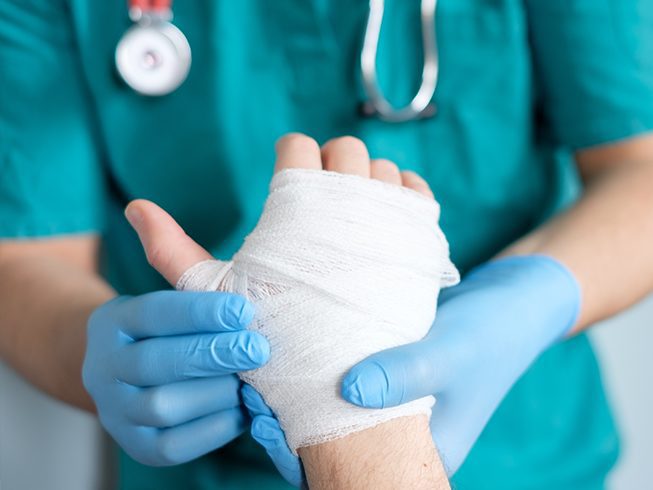
Call our office today at (317) 401-8626 to discuss your case.

 317-401-8626
317-401-8626 